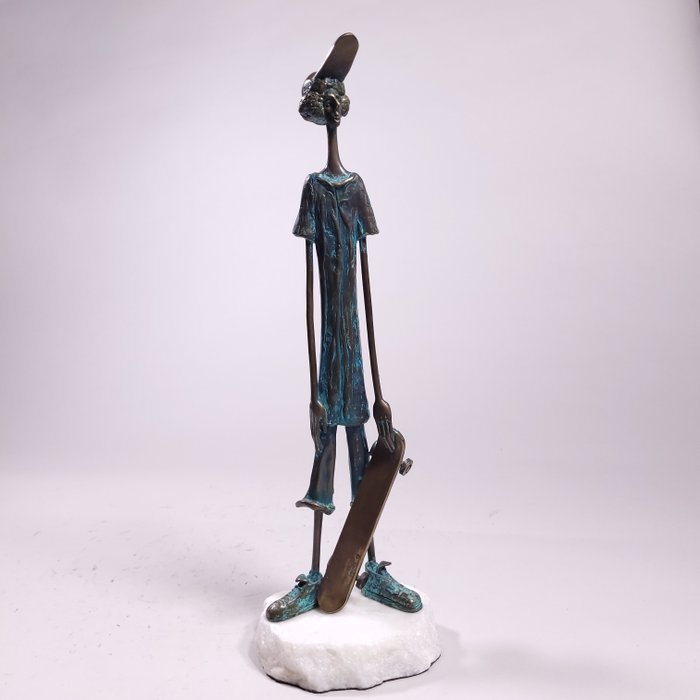
Iwa Kraj - Two brids under an umbrella (Bronze)
Nº 82446871

Nº 82446871

Paweł Erazmus, born in 1969, graduated from the Faculty of Sculpture at the Academy of Fine Arts in Krakow with very good results, which was confirmed in his Master of Arts diploma by: the then Dean of the Faculty of Sculpture, a sculptor, Prof. Jerzy Nowakowski and the Rector of the Academy of Fine Arts, Prof. Włodzimierz Kunz. Born into an intelligentsia family, who came to Krakow from Stalowa Wola, from the pre-war Central Industrial District, this shy, young man with the appearance of a film enthusiast studied in the years 1989-1994 in the studio of one of the most outstanding Polish monumentalists, a sculptor, Professor Marian Konieczny. His talent was revealed many years before he arrived in the "Mecca of Polish artists", Krakow. At the age of just a few years, he was able to conjure up fairy-tale characters and surprising "sculptural images" of the world then viewed from a "frog's perspective" in plasticine, with his tiny fingers.
During his studies, in 1994 he began to present his works, initially in Krakow, and later as part of collective exhibitions of students of the Academy of Fine Arts in German cities: in Düsseldorf and Krefeld (1992) and in 1993 in Maastricht (the Netherlands) and Solingen ( Germany). Unique, perfect, poetic, small bronze sculptures aroused great interest among both critics and the general public.
In 1994, at the TPSP Palace of Art in Krakow, during a postgraduate exhibition of "fresh" graduates of the Academy of Fine Arts, among many excellent works by young artists, I noticed a small collection of sculptures by Paweł Erasmus. I must admit that they made a stunning impression on me, they captivated me and I returned to this part of the exhibition many times. A few days later, I personally met Paweł Erazmus, who had been thrown into "deep water" in Krakow.
It was the beginning, on the one hand, of my discreet observation of his artistic development, and on the other, of the systematic expansion of my modest collection of his sculptures, in which the first exhibit was the Archer.
In the years 1995-1998, the artist presented his sculptures, as he called them, in various galleries: from the "Rover" Salon of Mr. and Mrs. Misiak in Krakow (in 1996, a joint idea for the exhibition entitled Diplomas 1994, 1995 in the Car Salon, the president of the Jagiellonia Publishing House Wojciech Taczanowski and mine as part of RC Kraków), through the Spring Salon at the TPSP Palace of Art (1966), in the "Pod Złotym Lewkiem" gallery of the Górecki family at ul. Szewska in Krakow, in Copenhagen (1997), to the first individual exhibition at the Labirynt Gallery at ul. Floriańska in Krakow (1999) In June 1994, at my request - the president of the Nowodworski Tennis Club at the 1st Secondary School in Krakow - Paweł Erazmus made a unique statuette of Tennis Player, which was a reward for the best high school students in tennis tournaments, and a little later, the Bird-Singer. , which was a prize in the Foreign Language Song competition at the same high school. During their implementation, I could observe the creation process and the extraordinary talent and ability to transmit synthetic, artistically filtered information about the model from "eyes to hands". In reviews from seventeen exhibitions, both art critics and journalists unanimously emphasize the ease with which Paweł Erazmus refers to history and legends, and the enormous imagination with which he presents the dynamics of people and animals. Through exaggeration and deformation of hands, legs and expressiveness of the face, he freely directs the observer's imagination and highlights the anecdote.
Created using the old lost wax technique, dating back to ancient Egypt, the sculptures are extremely precise and intimate, able to decorate both palaces and modern apartments. Paweł Erazmus's sculptures bring many aesthetic experiences and deep philosophical reflections to their lucky owners and their guests! More complicated compositions, despite the formal charade, are quite clear to astute observers.
After over seven years of observing his artistic achievements, I decided that it was time to show his sculptures at the TPSP Palace of Art in Krakow. In January 2002, an individual exhibition of sculpture by Paweł Erazmus was organized in the Wyspiański Community Room at the Palace of Art. The exhibition was accompanied by the release of this Album, and for the first time in history, TPSP produced a film about the sculptor, Paweł Erazmus, as part of the series: "Artists' Gallery of the Palace of Art" (director - Stefan Szlachtycz, cinematographer - Jerzy Drużkowski).
These two synchronous publications accompanying the exhibition of Paweł Erasmus's sculptures are a total promotion of his art, as well as the intellectual and technical possibilities of the 21st century, of excellent Polish art in Poland and the uniting Europe.
Comment acheter sur Catawiki ?
1. Découvrez des objets d’exception
2. Faites la meilleure offre
3. Effectuez un paiement sécurisé